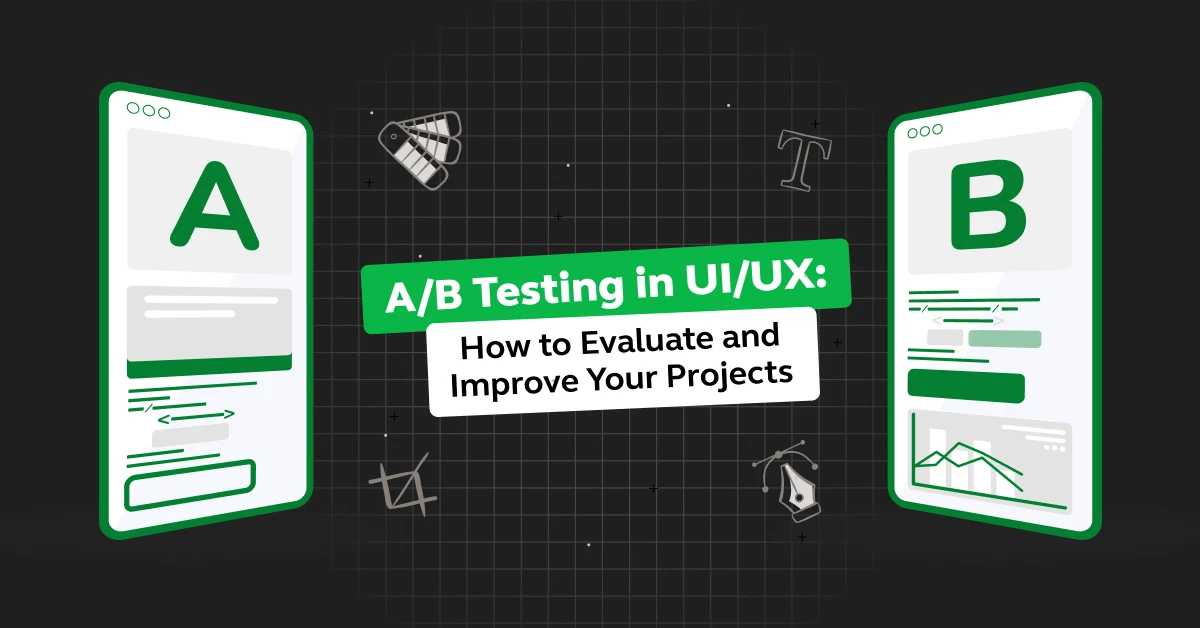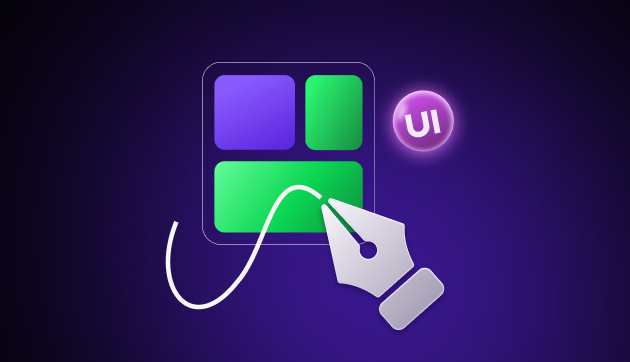
A/B Testing in UI/UX: How to Evaluate and Improve Your Projects?
Mar 11, 2025 5 Min Read 4982 Views
(Last Updated)
UI/UX design is an ever-evolving field that focuses on creating the best user experience for products and services. One of the most crucial aspects of UI/UX research is understanding and meeting the varying needs of the end users.
Designers spend a significant amount of time connecting with users, identifying pain points, and ensuring that the final product or service delivers an enriching experience.
However, making design decisions can be challenging, especially when choosing between two versions of a design or deciding whether to incorporate a specific feature. This is where A/B testing comes into play.
In this article, we will explore the concept of A/B testing in UI/UX design, understand its significance, and learn how to conduct meaningful tests.
We will discuss the benefits of A/B testing, popular tools for conducting tests, what to A/B test, how to conduct A/B testing effectively, and how to analyze the results. So, let’s dive in!
Table of contents
- Defining A/B Testing
- Why is A/B Testing Important in UI/UX?
- Assessing and Analyzing Needs
- Democratizing the Design Process
- Selecting the Best Features
- Benefits of A/B Testing in UI/UX
- Increased User Engagement
- Reduced Bounce Rate
- Improved Conversion Rate
- A/B Testing Tools in UI/UX
- Google Optimize
- Optimizely
- Crazy Egg
- AB Tasty
- Adobe Target
- How to Conduct A/B Testing Effectively?
- Define Your Goals
- Identify Key Metrics
- Select the Right Audience
- Randomly Split the Audience into Groups
- Test One Variable at a Time
- Allow Sufficient Test Duration
- Consolidate and Analyze Results
- How to Analyze A/B Testing Results?
- Conclusion
- Why is AB testing important?
- What is AB testing optimization?
- Why testing is so important with UX?
- What is the purpose of user testing in UI UX design?
Defining A/B Testing
A/B testing, also known as split testing, is a standard experimentation process in UI/UX design. It involves comparing two versions of a product or service to determine which design performs better.

During an A/B test, users are randomly divided into two groups, with each group interacting with a different version of the design.
The data collected from these interactions, such as task completion time, success and failure rates, and overall satisfaction, helps in making informed design decisions.
Read More: UI/UX Best Practices: Creating Exceptional Digital Experiences
As we proceed to the next phase, make sure you understand the fundamentals of UI/UX, which includes heuristic analysis, journey maps, testing, etc. If you want to explore more about it, join GUVI’s UI/UX Course with Placement Assistance. You’ll also learn about the tools used in UI/UX which are AdobeXD, Illustrator, Photoshop, Figma, and many more. Build some amazing real-time projects to get hands-on experience.
Also, if you want to explore Figma through a Self-paced course, try GUVI’s Figma certification course.
Why is A/B Testing Important in UI/UX?
A/B testing plays a crucial role in understanding user behavior and meeting the needs of the target audience.

It allows designers to gain valuable insights into user preferences and expectations by comparing different versions of a design in a natural environment. Here are some key reasons why A/B testing is important in UI/UX design:
1. Assessing and Analyzing Needs
A/B testing helps designers understand the needs and expectations of the target audience. By dividing users into two groups and letting them interact with different designs, designers and researchers gain a deeper understanding of their behavioral patterns.
This information is invaluable as users interact freely with the designs in their respective contexts.
Learn About User Flow in UX Design: 11 Important Steps to Look After
2. Democratizing the Design Process
A/B testing in UI/UX democratizes the design process by giving users a voice in design decisions. When users interact with different versions and provide feedback, their opinions influence the design choices.
This ensures that the target audience is empowered and their needs are considered, resulting in a more user-centric design.
3. Selecting the Best Features
Comparing two versions of a design through A/B testing in UI/UX helps identify the strengths and weaknesses of each version. This enables designers to select the best features from each version, creating a final design that meets the majority of user needs.
Also Read: Animation in UI/UX: Captivating Designs Through Motion.
Benefits of A/B Testing in UI/UX
A/B testing in UI/UX offers numerous benefits for users, designers, and organizations. Let’s explore some of the key benefits:
1. Increased User Engagement
A/B testing helps designers create user-friendly interfaces that enhance user engagement. By analyzing data from A/B tests, designers can optimize the user experience, resulting in increased user satisfaction and loyalty.

2. Reduced Bounce Rate
A/B testing in UI/UX allows designers to identify and address usability issues that cause users to leave a website or application.

By understanding user behavior and improving the content strategy, designers can reduce bounce rates and improve the overall user experience.
3. Improved Conversion Rate
A/B testing in UI/UX can significantly impact conversion rates by refining the design elements that drive conversions.

Through A/B tests, designers can optimize campaigns, strengthen calls to action, and provide personalized experiences for users, ultimately improving the conversion rate.
Also Explore 21 Best AI Tools For UI/UX Designers in 2024
GUVI’s UI/UX Design Course will help you master all UI/UX fundamentals via lessons from top industry experts who will also help you build projects and make an intriguing portfolio.
A/B Testing Tools in UI/UX
Several tools are available to facilitate A/B testing in UI/UX design. These tools streamline the data collection and analysis process, making A/B testing more efficient and effective. Here are some popular A/B testing tools:

1. Google Optimize
Google Optimize is an excellent tool for running A/B tests on websites. It allows designers to split their websites into two versions and gather data separately. Integrating Google Optimize with tools like Google Analytics and Ads enriches the analysis.
2. Optimizely
Optimizely offers a range of features for A/B testing in UI/UX, providing access to valuable data and test results. With Optimizely’s experimentation product, designers can set up A/B tests at different customer touchpoints, ensuring a comprehensive understanding of the overall user experience.
3. Crazy Egg
Crazy Egg provides a user-friendly A/B testing tool that simplifies the entire testing process for designers and researchers. From setup to data collection and analysis, Crazy Egg makes conducting A/B tests easy and intuitive.
4. AB Tasty
AB Tasty is a tool dedicated to split testing, allowing designers to create and conduct A/B tests without coding experience. With AB Tasty, designers can create personalized experiences for different user groups and gather valuable data.
5. Adobe Target
Adobe Target offers a range of exciting features for A/B testing in UI/UX, covering various aspects of split testing. Designers can create A/B and multivariate tests, collect comprehensive qualitative and quantitative data, and gain valuable insights for design decision-making.
Find Out 14 Best AI Image Generator Tools
How to Conduct A/B Testing Effectively?
Now that we understand the importance and benefits of A/B testing in UI/UX, let’s explore the best practices for conducting A/B tests effectively:
1. Define Your Goals
Before conducting A/B tests, it is crucial to define the goals of the testing process. This ensures a clear understanding of the product or service being tested, the organization’s objectives, and the target audience’s needs.
2. Identify Key Metrics
Identify the key metrics to be evaluated and analyzed during the A/B testing process. Collaborate with product developers, marketing professionals, and other relevant teams to determine the areas that need monitoring.

Gather data from user testing, market analysis, and competitive research to inform your decisions.
3. Select the Right Audience
Recruit the right participants for your A/B test to ensure its success. Creating user personas can help understand the traits, behavioral patterns, and defining characteristics of your target audience. Selecting the right users enhances the value of the data gathered during the tests.
Find Out Top 10 UI Design Patterns: Creating Intuitive and Engaging User Experiences
4. Randomly Split the Audience into Groups
To ensure both versions of a design receive enough interaction, divide the audience randomly into two groups. One group interacts with one version, while the other group interacts with the alternative version.

Random assignment eliminates biases and ensures unbiased data collection and analysis.
5. Test One Variable at a Time
Focus on testing one variable at a time during A/B testing in UI/UX. While it may be tempting to test multiple variables simultaneously, it is impractical and can lead to inaccurate results.
By focusing on one variable, you can gather valuable data that leads to effective design decisions.
6. Allow Sufficient Test Duration
For meaningful results, allow sufficient time for your A/B test to run. Adequate data collection is crucial for accurate analysis. Similar to other design techniques, such as user testing, it is essential to collect a sufficient quantity and quality of data for thorough analysis.
7. Consolidate and Analyze Results
After collecting test data, consolidate and analyze the results. Use statistical methods to analyze quantitative data. Combine the findings of A/B testing in UI/UX with other methods, such as contextual inquiry and user testing, to gain a holistic view of the user experience.

The aim is to make the user’s life easier and improve the design based on the insights derived from the tests.
How to Analyze A/B Testing Results?
Analyzing A/B testing results is a crucial step in the process as it dictates design decisions and provides direction for projects. Here’s how you can analyze A/B testing results effectively:
- Review Key Metrics: Start by revisiting the key metrics identified at the beginning of the A/B testing process. Refresh your memory and focus on the overall goals of the design project.
- Conversion Rate Analysis: Conversion rates are essential metrics to evaluate during A/B testing in UI/UX. If one version shows higher conversions, investigate the elements that contribute to this success and consider incorporating them into the final design.
- Quantitative Analysis: Utilize statistical methods, such as hypothesis testing, correlation tests, and regression analysis, to identify statistically significant results. These findings can inform decision-making processes.
- Qualitative Analysis: Consider qualitative aspects of A/B testing, such as user journeys and heatmaps, to understand user behavior patterns. Incorporating qualitative analysis into the overall analysis provides a comprehensive understanding of the user experience.
Kickstart your UI/UX journey by enrolling in GUVI’s UI/UX Course where you will master technologies like AdobeXd, Illustrator, and Figma, and build interesting real-life UI/UX projects.
Alternatively, if you would like to explore Figma through a Self-paced course, try GUVI’s Figma’s certification course.
Conclusion
A/B testing is an essential process in UI/UX design that allows designers to make informed decisions and create user-centric designs.
By comparing two versions of a design and analyzing user interactions, designers can optimize user engagement, reduce bounce rates, and improve conversion rates.
As a UI/UX designer, it’s crucial to embrace A/B testing as a valuable tool in your toolkit. By continuously learning and exploring new methods, you can ensure the success of your design projects and deliver exceptional user experiences.
Also Explore: 10 Important UI/UX Testing Tools For UI/UX Designers
AB testing is crucial for optimizing and improving digital experiences by comparing two versions (A and B) to determine which performs better.
AB testing optimization involves systematically comparing variations of a webpage or app to identify the most effective elements that drive desired outcomes.
Testing is vital for UX to ensure a user-friendly and effective design, helping identify and address issues that may impact user satisfaction and engagement.
User testing in UI UX design aims to gather feedback directly from users, enhancing the design process by uncovering insights and refining the interface based on real user experiences.











![What Does a UI/UX Designer Do? [Career Guide] 13 What does a UI/UX designer do?](https://www.guvi.in/blog/wp-content/uploads/2023/12/UX-Designer-Do_.webp)




![How To Switch Career In UI/UX Design? Easy or Hard? [2025] 16 how_to_switch_to_a_career_in_ui_ux_design_](https://www.guvi.in/blog/wp-content/uploads/2023/12/how_to_switch_to_a_career_in_ui_ux_design_.webp)


Did you enjoy this article?